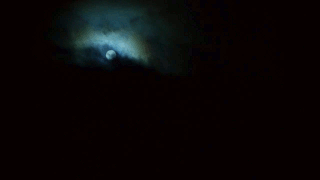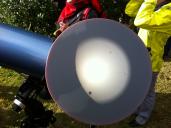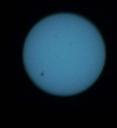
It allows to keep PV going, with more focus towards AI, but keeping be one of the few truly independent places.
-
I've been told pointing your camera directly at the sun can damage the sensor but I was wondering if any or all of that potential damage can be mitigated with the proper filter or not. I plan on using a heavy ND filter and from what I read it appears safe but wanted to get a second opinion.
-
Yes, a heavy ND is all you need. I've shot a partial eclipse, sunny timelapses and super-moons with it. I love my Hoya 400x. :)
Of course if you are shooting very wide, I shoot facing into the sun without an ND all the time. I think last year I had hundreds of thousands of exposures fitting that description.
By the way, this was shot without any ND, too, using the Canon L series 600mm f/4 with their EF III 2x teleconverter.
-
Good to get confirmation, as I couldn't wait. :) I did a little testing earlier with an old 200mm tele Takumar lens, a 2x teleconverter in ETC mode and a heavy ND filter. I could see sunspots pretty well so, weather permitting, Venus should be fairly easy to see.
p.s. @thepalalias I like the part in your video where it looks like a nuclear explosion going off, which make perfect sense seeing that's exactly what the sun is.
-
@thepalalias That's fantastic. Very nice work. Makes me want to pick up an ultra telephoto and try more sun videography for myself.
-
@disastronaut @Sangye Thanks. :)
-
Talked to an astronomer friend about fitting a camera to one of those machine-tracking tripods they use with telescopes.
Then I just saw this solution:
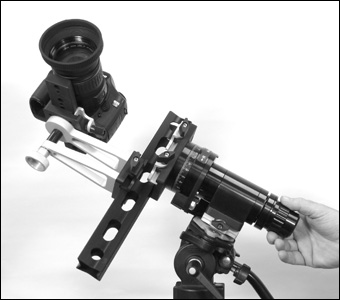
Starlapse system - Basic system $575
Designed for the astronomer as well as the serious videographer, the StarLapse system will accurately track your camera or telescope for celestial observation.
Using the same worm-gear drive system as the time-tested Losmandy GM-8 German equatorial mount (but without the declination portion) the StarLapse will maintain accurate tracking at both sidereal and solar rates for razor-sharp astro-photographs.
In addition to sky viewing, the StarLapse can add dynamics to time-lapse videography by permitting camera motion during the duration of the shot. The camera can be set up to pan or tilt at nine different speeds from 7.5° to 240° per hour to provide smooth camera motion at any frame rate.
-
I tried to capture the full moon last night with gh2 + an old beroflex 70-210 lens. I couldn't get both the nice graded moon details and the clouds at the same setting, the histogram didn't fit both, either crushed one or the other.
I wish so much that there was a way to compress the DR.
-
@thepalalias Those images look superb. Always nice to shoot with a tele at the horizon. I'm going to try and find a 600mm :)
-
@johnnym Thanks. :) The cheapest 600mm are third-party and often for other mounts. I have not looked into mounting telescopes too much or into spotting scopes, but those are two other options to consider. If I had the money, the 600mm f/4 is one of the two lenses I would most want (right up there with the Leica 50mm f/0.95 Noctilux). :)
@kankala Use AEB with EV distance set to 1EV and shoot 7 exposures at a time. This will give you a better chance of capturing all of it, but you still have to deal with the shake/motion in the shot and with framing it in such a way as to get close enough to the moon to get the detail you want while still getting the other things in the shot.
The HDR programs that are better at handling these sorts of things really do a good job if you apply them correctly, in terms of making the whole scene happen.
-
repost from topic I created earlier:
Just shot this in my parking lot around 3:30 PST. A little blurry at first, but it gets a better mid-way through.
Shot with GH2, Panny 14-140, Ex. Tele, Variable ND, ISO 160, 1/2000th, Spanmybitchup (old school!) Sped up in FCPX about 800%.
@thepalalias - curious to see what you shot at the observatory. Thanks for reminding me!
-
Here is the video I took of the Venus Transit with my kids commenting on this once in a lifetime event.
This was filmed with Panasonic GH2 and the 14-140mm lens with a $40 Polaroid variable ND filter. It is not a great filter but it worked for what I wanted it to do.
There really are not that many cameras that can capture video, audio, and images simultaneously. In order to capture the entire event and the observers reaction you really need a camera like the GH2.
It would have been far better if I had used my telescope and the proper filters. However, I had my kids with me and it was just too much trouble to setup the big scope while taking care of them.
I simply set the GH2 on the tripod and hit record and this is what it captured.
-
Still editing the video:
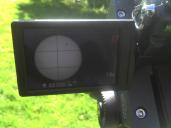
 transit.jpg2592 x 1936 - 413K
transit.jpg2592 x 1936 - 413K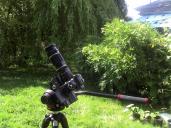
 transit-2.jpg2592 x 1936 - 1M
transit-2.jpg2592 x 1936 - 1M
Howdy, Stranger!
It looks like you're new here. If you want to get involved, click one of these buttons!
Categories
- Topics List24,036
- Blog5,725
- General and News1,375
- Hacks and Patches1,153
- ↳ Top Settings33
- ↳ Beginners256
- ↳ Archives402
- ↳ Hacks News and Development56
- Cameras2,382
- ↳ Panasonic995
- ↳ Canon118
- ↳ Sony156
- ↳ Nikon96
- ↳ Pentax and Samsung70
- ↳ Olympus and Fujifilm102
- ↳ Compacts and Camcorders300
- ↳ Smartphones for video97
- ↳ Pro Video Cameras191
- ↳ BlackMagic and other raw cameras130
- Skill1,960
- ↳ Business and distribution66
- ↳ Preparation, scripts and legal38
- ↳ Art149
- ↳ Import, Convert, Exporting291
- ↳ Editors191
- ↳ Effects and stunts115
- ↳ Color grading197
- ↳ Sound and Music280
- ↳ Lighting96
- ↳ Software and storage tips266
- Gear5,420
- ↳ Filters, Adapters, Matte boxes344
- ↳ Lenses1,582
- ↳ Follow focus and gears93
- ↳ Sound499
- ↳ Lighting gear314
- ↳ Camera movement230
- ↳ Gimbals and copters302
- ↳ Rigs and related stuff273
- ↳ Power solutions83
- ↳ Monitors and viewfinders340
- ↳ Tripods and fluid heads139
- ↳ Storage286
- ↳ Computers and studio gear560
- ↳ VR and 3D248
- Showcase1,859
- Marketplace2,834
- Offtopic1,328



